The Samsung 860 QVO (1TB, 4TB) SSD Review: First Consumer SATA QLC
by Billy Tallis on November 27, 2018 11:20 AM ESTAnandTech Storage Bench - The Destroyer
The Destroyer is an extremely long test replicating the access patterns of very IO-intensive desktop usage. A detailed breakdown can be found in this article. Like real-world usage, the drives do get the occasional break that allows for some background garbage collection and flushing caches, but those idle times are limited to 25ms so that it doesn't take all week to run the test. These AnandTech Storage Bench (ATSB) tests do not involve running the actual applications that generated the workloads, so the scores are relatively insensitive to changes in CPU performance and RAM from our new testbed, but the jump to a newer version of Windows and the newer storage drivers can have an impact.
We quantify performance on this test by reporting the drive's average data throughput, the average latency of the I/O operations, and the total energy used by the drive over the course of the test.
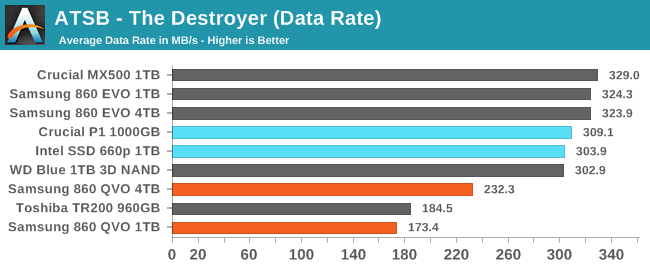
The 1TB Samsung 860 QVO does not handle The Destroyer very well, with an average data rate that is slightly slower than the DRAMless TLC drive. By comparison, the NVMe QLC drives from Intel and Micron are only slightly slower than the 860 EVO and MX500.
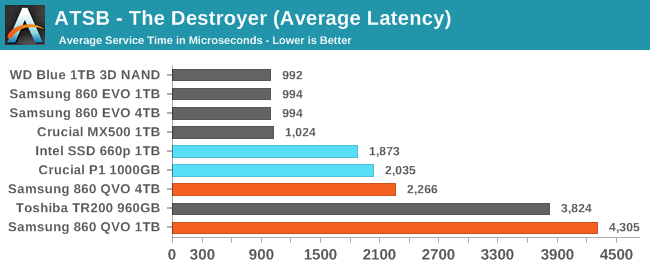

The QLC drives in general stand out more when looking at latency metrics than throughput, and especially when looking at 99th percentile latencies. The 1TB 860 QVO comes in last place for both average and 99th percentile latency, and all three QLC drives have worse 99th percentile latency than the DRAMless TLC drive.
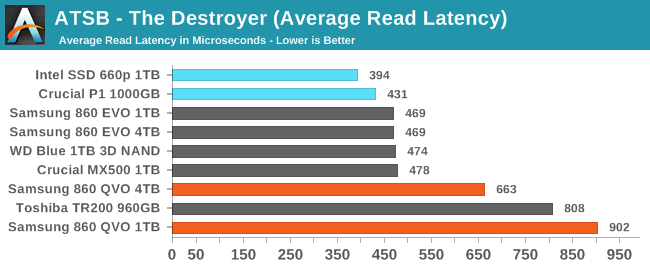
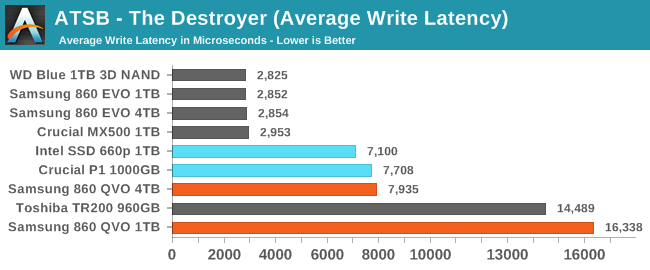
The average read and write latencies of the 860 QVO are both only slightly worse than the DRAMless TLC SSD. The NVMe QLC drives are slightly faster than the mainstream SATA drives for read latency but fall behind in average write latency.
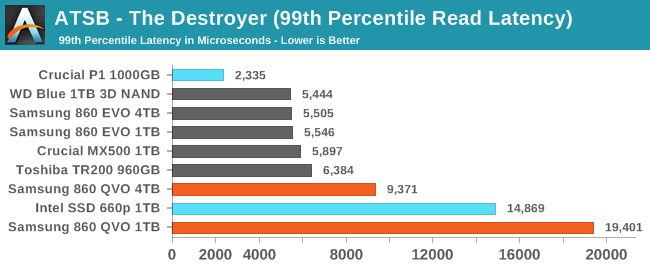
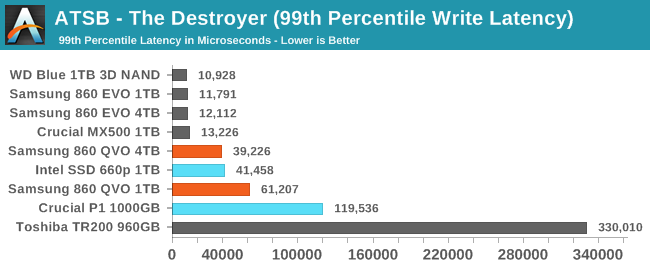
The 860 QVO actually doesn't come in last place for 99th percentile write latency, and in fact scores far better than the DRAMless TLC drive. However, the QLC drives are all still far worse off than the mainstream TLC SATA drives.

With low performance dragging out the test to a far longer duration, it's no surprise that the QLC drives all use much more energy over the course of The Destroyer than most SATA drives. The DRAMless Toshiba TR200 is an impressive exception that manages to be very efficient despite its low overall performance.










109 Comments
View All Comments
stanleyipkiss - Tuesday, November 27, 2018 - link
Sell me a 8 TB QLC SSD for $400 and I'll bite. That's what QLC is for: moving off of spinning rust and onto SSDs with my bulk storage. Until then, this is useless without MASSIVE price drops. They are trying to milk saps who can't tell the difference between SSDs (i.e. normal consumers) by not dropping prices... yet.The race to the bottom for SSDs is coming. The manufacturers are just greedy enough not to want it to happen too soon.
But give me an 8TB or bigger SSD for $400 and I'll be the first to buy it. I'll even buy two!
R0H1T - Tuesday, November 27, 2018 - link
Yeah no one's selling you 8TB for $400 anytime soon. Aside from the fact that the R&D costs for QLC need to be recuperated first & companies need to reinvest an increasing amount for future development, there's also a point after which it doesn't make sense for the SSD, or NAND, maker to sell these at a loss.If you really want something that big, for dirt cheap, try spinners instead.
shabby - Tuesday, November 27, 2018 - link
How will they recoup the price when no one is going to buy this? The evo 860 is cheaper.R0H1T - Tuesday, November 27, 2018 - link
So you think the 860 QVO will stay at 15c/GB for the rest of it's time on the market or have you not seen high prices at launch, for any other product before this?shabby - Tuesday, November 27, 2018 - link
Obviously no, but why launch it at this price from the start. Should of launched it at $99 for 1tb that would probably get it some fanfare.R0H1T - Tuesday, November 27, 2018 - link
Early adopter tax? Samsung is usually the first to launch "one of a kind" products in the retail market & they get the ball rolling for many of the innovations in this industry. The prices would come down sooner if the competitors launch their SATA QLC drives quickly.shabby - Tuesday, November 27, 2018 - link
I doubt anyone will be rushing to the store to buy these.Ironchef3500 - Wednesday, November 28, 2018 - link
+1Jad77 - Wednesday, November 28, 2018 - link
"I doubt anyone will be rushing to the store to buy these."That is the perfect one-line review!
moozooh - Tuesday, November 27, 2018 - link
Yeah, the problem here is that the QVO is not a "one of a kind product"—in every possible aspect and scenario it's either the same as the EVO or worse, sometimes very substantially so, without being substantially cheaper. Right now there is exactly zero reason to choose it over the EVO. In order to compete with it favorably the QVO needs to be at least 25% cheaper to offset the disadvantages. In other words, under 11 c/GB. Until then nobody would be willing to give this inferior product the time of the day.